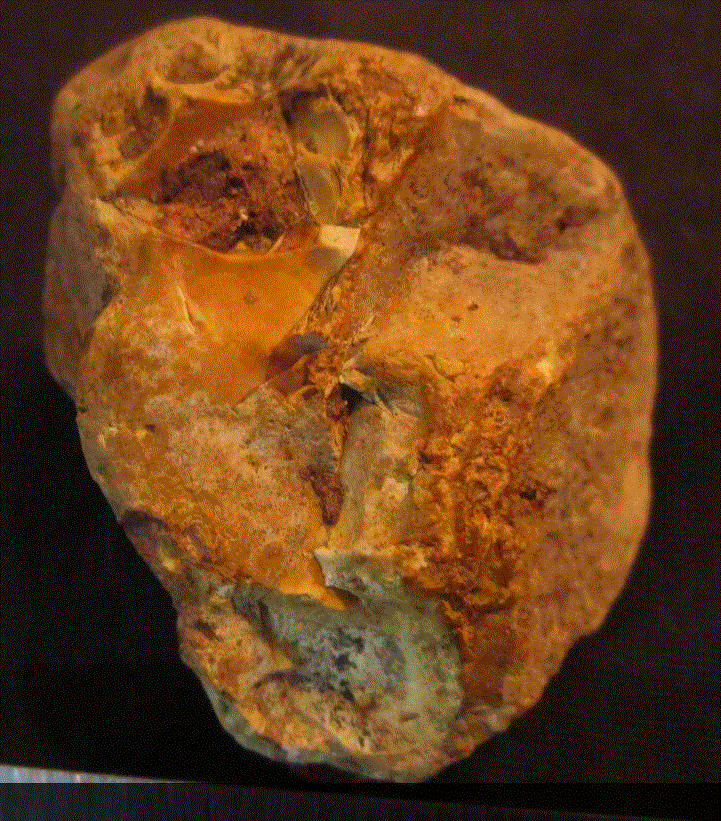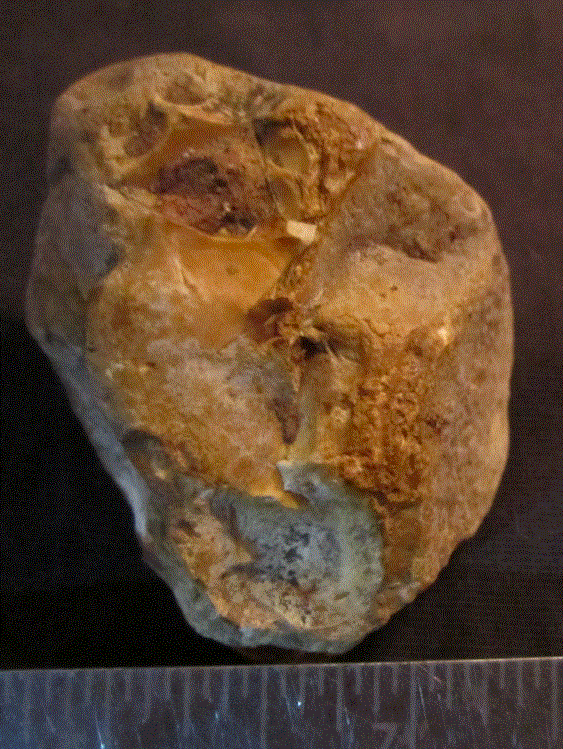David Boies artifact find, near Austin, Texas
This figure evidences stone removal on the "right eye, the nose" and the "mouth" made to affect the final desired image of a chert pebble face mask expressing the pervasive portable rock art motif of "One eye open, other eye shut or missing."
This motif dates to the Acheulean and may also be seen in Middle-Paleolithic European assemblages, according to art and religion scholar James Harrod, Ph.D., at OriginsNet.
View 2 of this worked pebble with scale in inches.
The face looking at us straight-on has the left profile of another face occupying its left side. The two faces share the same stone feature as a "nostril."
“There Is Nothing New Under The Sun.” Ecclesiastes 1:4-11
David Boies Austin, Texas finds, side by side and compared to France cave rock art painting.
Author Barbara Olins Alpert describes a simplistic face made by addition of three painted black lines to a naturally-suggestive form in a cave at Vilhouueur (Charente, France) seen pictured here and dated to ca. 25,000 years before present. See her illustration below.
Figure 4.26 from Barbara Olins Alpert's The Creative Ice Age Brain: Cave Art in the Light of Neuroscience.
David Boies Austin, Texas finds, side by side and compared to France cave rock art painting.


+mark+2+pub.gif)




Hello Ken,
ReplyDeleteIn all of the above presented objects, I can not see how they were adapted by humans. To me they all have a natural cause, such as frost and other weathering influences. In case of worked pebbles, the find of David Boies has features that are rather impossible to create in the LP-MP period you would need an iron chisel to work this precise on such a three cm wide stone and in such case I wonder of the raw material, which looks like a polluted quartz was suitable for it; exactly this is the problem: how, how did they make it? A 90 degrees carving of a mouth is not easy especially in this shape, like the 'mouth'. For nature, the dissolution of e.g. sandstone in such incisions could leave such patterns. So technologically there are many questions. Besides of the capability for its precise locomotion, the question is what tools were used to make such tiny and even precise carvings. Did anyone now copied rock art objects by experiments with the primitive tools available? It is not that I do not believe in portable rockart and even more, how difficult it would be to interpret this rock art from our point of view, even when we consider we are not the same species compared to eventually Middle Palaeolithic hominids in Northern america ( if the proof is there, but this is not my subject). Still, on the contrary, the objects could be manuports, where pebbles with hominid appearance were taken into the camps. I am very interested in explanations about the technical characteristics of the production process of such portable rock art. I think, a good, solid technical explanation would pave the way for more acceptance and understanding for such possible special objects in archeology.
Wit my regards,
Jimmy Groen
Jimmy, these artifacts were probably made with either a bone tool, like an awl or with animal teeth as in a canine. If you need more info on tools used by Native Americans, take a trip to a reservation and speak to the folks there. The answers to a lot of our questions can be answered by them, but no one thinks to ask them. Sincerely, David Boies
ReplyDeleteHello David,
ReplyDeleteThanks for your reply on my comment. It is absolutely not the case that I do not believe in possibilities for sculpturing rocks but this depends on the type of raw material. The raw materials, presented in this post, are quartz (left image) and a crystalline rock with heavy weathering features (right).
I just wonder how a mouth or an eye can be sculpted in quartz, with only prehistoric tools like bone or animal teeth. In experiments with quartz, where I tried to make sharp cutting tools – similar to those used in the Paleolithic in Europe- I found out how difficult it was , even to make a sharp edge at a piece of quartz. A mouth or eyes, this deep and in a 90 degree angle is in my opinion impossible, unless you have ultra modern equipment, like a precise diamond borer. In my experiences, carving in quartz (and even fine carving, just like making a mouth or an eye of only two millimeters wide) was impossible, it was more like pulverizing the rock and even to become a sharp working edge, it became quickly rather messy.
The crystalline rock in the image right shows some patina and weathering which are natural causes for the open and closed eye and the mouth. The open eye, in my opinion has been formed by a former frost fracture which must be very old, considering the rounded edges around it. The fill of this fracture consists of a fine matrix where oxidized sand grains occur; this pebble definitely comes from a waterlogged paleo –environment, such as a river.
So I am very interested in the technique applied on boring and carving the types of rocks presented in this post, as these are the most difficult to adapt. What is more likely in such case is, these could be manuports, chosen for their image. In case of sculpting, I would choose other, more soft types of rock such as limestone, slate, sandstone or soapstone.
That is why I wonder how it was done. Maybe you know some pages on the web where experiments were carried out in these materials, or people that are familiar with sculpting know how to do it.
With my regards,
Jimmy
Bocholtz, The Netherlands
In archaeology, context is King. For art we don't start with known technology and then identify artifacts, we start with art and then figure out the working technologies. They may differ substantially from those commonly known from tools. The art technologies may take a very long time to understand and replicate for those of us outside the miliue in which they were created. We do not know all which is to be known about stone working in the grand human past.
ReplyDelete